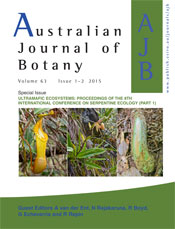Australian Journal of Botany
Volume 63
Numbers 1 & 2 2015
Ultramafic Ecosystems: Proceedings of the 8th International Conference on Serpentine Ecology (Part 1)
The 8th ICSE was hosted by Sabah Parks in Malaysia attracted 174 participants from 31 countries and was the first held in Asia, the region that hosts some of the world’s most biodiverse ultramafic ecosystems. Here we summarise some of the contributions made during the 8th ICSE and describe some of the exciting challenges awaiting future research.
Serpentine soils derived from ultramafic rocks have a worldwide distribution. They are rich in Ni, Cr and sometimes Co, but are poor in essential nutrients, such as N, P, K and Ca. Many plants that hyperaccumulate Ni are endemic to serpentine soils. The rhizosphere of these endemic plants provides a complex and dynamic microenvironment where the roots of hyperaccumulator plants, along with associated microbes, form a unique ecosystem with an extraordinary phytoextraction function. This study examines the potential for phytomining Ni using Alyssum serpyllifolium from serpentine soils in north-eastern Portugal.
Some of the survival-related physiological responses to different concentrations of Ca were compared to test Ca sensitivity in Alyssum inflatum (serpentine endemic) and A. lanceolatum (non-serpentine plant). On the basis of the observed responses, we introduce the serpentine plant A. inflatum as a stenocalcic plant. The results demonstrated the reason behind the uneven distribution of the plant on serpentine patches in its habitat.
We compared survival of a serpentine and a non-serpentine soil Alyssum species when exposed to variation in Ca : Mg ratio and ammonium and heat stress. The serpentine soil species was less tolerant of change in Ca : Mg ratio and also was more sensitive to both ammonium and heat stress. We conclude that the serpentine soil species may be more susceptible to anthropogenic environmental changes.
Interactions of Ni with different metals may affect Ni uptake and accumulation by the Ni-hyperaccumulator, Alyssum bracteatum. Negative correlations were observed between Ni and Mn concentrations in both roots and shoots. The results suggest a competition between Ni and Mn for uptake at root.
The specificity of some traits that are responsible for metal tolerance in metal hyperaccumulator plants could be clarified by studying the interactions of different metals. Studying the interactions of Ni and Cu in some Ni hyperaccumulator and non-accumulator plants from the genus Alyssum showed an specific stimulation of Cu uptake by Ni in Ni-accumulator plants. This finding hints that this particular feature may be among the characteristics that enable them to hyperaccumulate Ni, unlike their congeneric non-accumulators.
Effects of Ni on some of antioxidant activities in different Alyssum Ni hyperaccumulator and non-accumulators were investigated. The results showed that in hyperaccumulators, superoxide dismutase activity was decreased by Ni while glutathione reductase activity was increased. It is concluded that the accumulation of Ni could negatively affect some vital physiological processes.
The effect of the density of Alyssum murale for phytomining was studied at field scale. At Domosdovë, at densities of one and six plants per square metre, and at Pojskë, of four plants per square metre, the biomass yield was 10, 5 and 10 t ha–1, respectively. The mass of phytoextracted nickel was 77, 41 and 112 kg ha–1. We suggest that a density of four plants per square metre is suitable for phytoextraction with native populations of A. murale.
Cool temperate regions have fewer species that are able to hyperaccumulate nickel than tropical and subtropical areas, possibly because of the limited time that has elapsed since the last major glaciation. Our study focussed on discovering nickel accumulator or hyperaccumulator species on serpentines in the Middle and Southern Urals of Russia. Alyssum tortuosum appeared to be a nickel hyperaccumulator; however, populations differed in their ability to accumulate the metal. A more detailed study of populations is necessary to understand nickel hyperaccumulation potential in this taxon.
Hyperaccumulators store high concentrations of heavy metals in their leaves, and may have applications in biotechnology for plant-based mining and environmental remediation. We studied a tropical hyperaccumulator, Psychotria grandis, which grows on both normal and geologically nickel-enriched soils, and found that although the amount of nickel in its leaves varies widely, plants from both soil types have similar physiological ability to accumulate nickel. Most of the world’s hyperaccumulators occur in the tropics, but few previous studies have investigated tropical plants.
This study is one of a few works concerned with the effect of the association of hyperaccumulator plants on the efficiency of nickel phytoextraction. The objective was to compare the mono- and co-cropping of hyperaccumulator plant species. Two hyperaccumulator plants were the best candidates for improved phytoextraction efficiency. This work underlined that multi-species vegetation covers promote the development and activity of rhizosphere microorganisms and could improve phytoextraction.
The genus Phyllanthus has at least 42 species from various parts of the world reported to accumulate more than 0.1% nickel in their leaves. This paper compared nickel accumulation in seven species of Phyllanthus from the Philippines and reports Phyllanthus erythrotrichus as a hypernickelophore, accumulating more than 1% nickel in the leaves. Three of the species examined have potential in nickel farming.
Lichens usually contain ‘lichen acids’, many of which have a significant affinity for heavy metals. These substances may play a key role in detoxification, acting as selective chelators of metals. For three lichen species we tested, there was no significant difference in metal concentration; however, another species that contained norstictic acid had higher concentrations of elements. Further investigations may show the reasons for such high levels of metal accumulation and the possible implication of lichen metabolites in metal tolerance.
Among more than 400 nickel-hyperaccumulating plants known worldwide, the Queensland endemic Pimelea leptospermoides is unusual in showing a very wide range of nickel concentrations from high-nickel ultramafic soils. This work aims to determine whether the variations result from differences among the various plant populations or from different properties of the soils on which they grow; it shows that a combination of variations in soil pH and total soil Ni concentration account for the observed differences in plant behaviour. Other cases of wide differences in nickel uptake by species at different sites may also be explained in this way, and the detailed investigation of soil properties should accompany studies on the nickel-accumulating behaviour of these plants.
We conducted a study to examine whether serpentine and non-serpentine populations of Fimbristylis ovata represent locally adapted ecotypes by investigating their growth and potential for nickel uptake and tolerance under greenhouse conditions. The serpentine population showed significantly better growth and nickel tolerance than did the non-serpentine population. Our preliminary investigations suggest that the serpentine and non-serpentine populations may be locally adapted to their respective soils; however, additional studies are required to determine whether the populations deserve ecotypic recognition.
Arabidopsis halleri is a model Cd and Zn hyperaccumulator. Accessions of A. halleri subsp. gemmifera growing on calcareous soil contained high amounts of Cd in shoots, but Zn concentration in shoots did not reach the level required for a hyperaccumulator. Soil factors and natural variations of A. halleri may help us understand the plant mechanisms of metal accumulation and tolerance.
Certain plants have the extraordinary ability to take up high concentrations of heavy metals, but evolutionary theory predicts that this ability should impair other plant functions. This study asked whether one such affected function is the ability to compete against other species. Although our results did not support this trade-off, further studies on uncontaminated soils and with other competing species are warranted. Our results also suggested that the use of non-native plants to remediate metal-contaminated sites should require careful monitoring.
Toxic and essential elements were determined in plant aerial parts as well as in plant methanol/water and water extracts prepared from the herb Hypericum perforatum growing on and off serpentine soils. Results showed that the plant is Ni tolerant, but can accumulate trace elements at toxic levels. People should be careful when collecting herb from serpentine and using for medication.
Combining crops is a potential option to gain value from poor ultramafic soils cultivated for agromining. Co-cropping the Ni-hyperaccumulator Alyssum murale and Lupinus albus under controlled conditions showed a positive effect of P fertilisation on Ni uptake but a reduction in Ni concentration in A. murale, while L. albus accumulated high rates of Mn. Such association would increase productivity of serpentine soils provided appropriate P fertilisation in supplied.
Perennial herb Halacsya sendtneri grows exclusively in harsh serpentine soils of the Balkan Peninsula. It thrives in both open and shaded habitats. Colonising a wider range of habitats with different levels of sunlight enables it to more efficiently solve harsh soil features, and vice versa.




